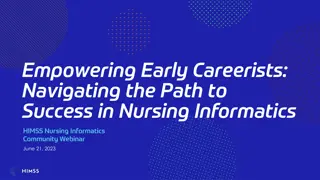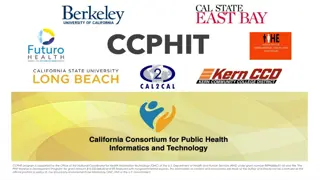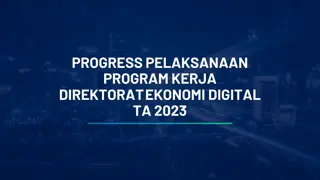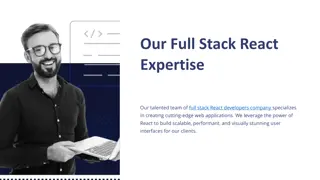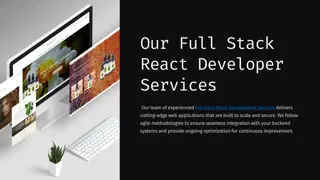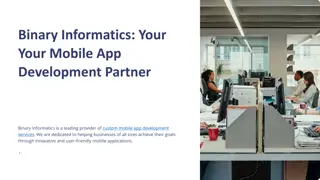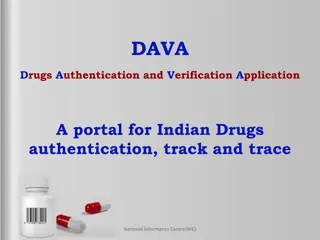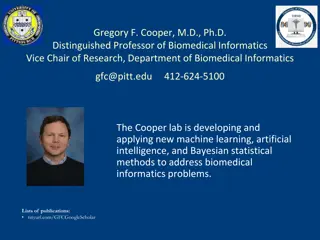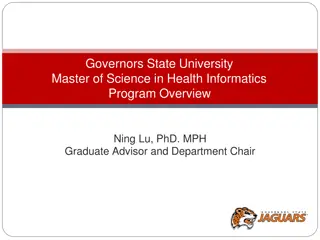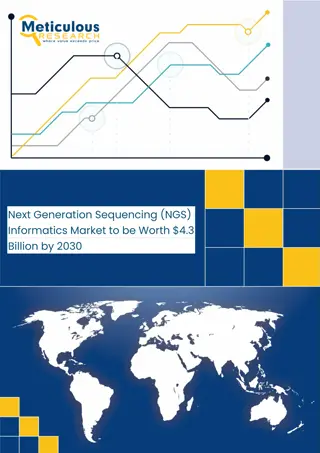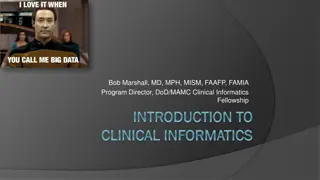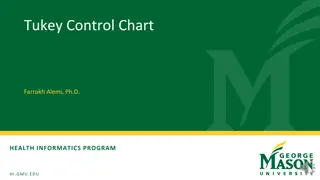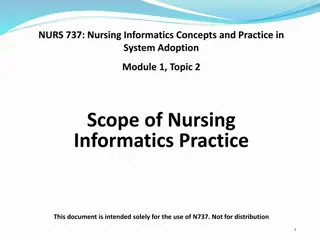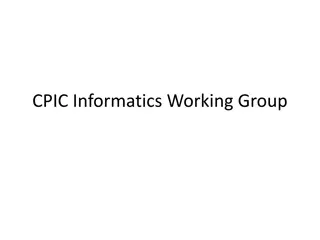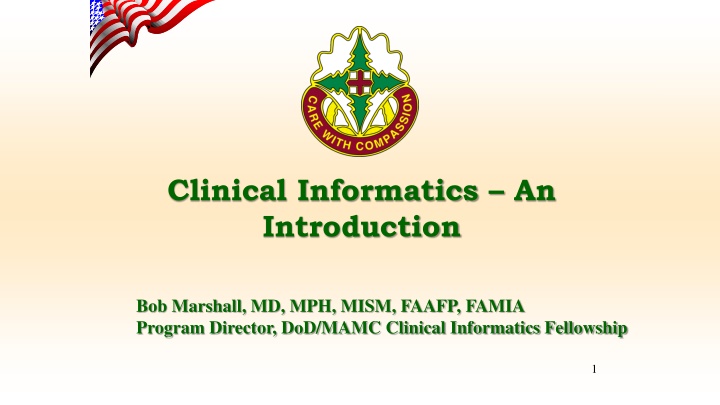
Clinical Informatics Overview and Roles in Healthcare Transformation
Explore the world of Clinical Informatics through an introduction to its key concepts, including the role of CI in optimizing healthcare information management and improving patient outcomes. Learn about the tasks and responsibilities of Clinical Informaticians in leveraging technology to enhance healthcare delivery and decision-making processes.
Download Presentation

Please find below an Image/Link to download the presentation.
The content on the website is provided AS IS for your information and personal use only. It may not be sold, licensed, or shared on other websites without obtaining consent from the author. If you encounter any issues during the download, it is possible that the publisher has removed the file from their server.
You are allowed to download the files provided on this website for personal or commercial use, subject to the condition that they are used lawfully. All files are the property of their respective owners.
The content on the website is provided AS IS for your information and personal use only. It may not be sold, licensed, or shared on other websites without obtaining consent from the author.
E N D
Presentation Transcript
Clinical Informatics An Introduction Bob Marshall, MD, MPH, MISM, FAAFP, FAMIA Program Director, DoD/MAMC Clinical Informatics Fellowship 1
Terminal Learning Objectives Overview of Clinical Informatics systems and capabilities Overview of the benefits of using data to answer important questions Overview of the research process Identifying a QI/PI topic 2
Definition of CI Discipline at the intersection of information science, computer science, and health care Deals with the resources, devices, and methods required to optimize acquisition, storage, retrieval, and use of information in health and biomedicine
Clinical Informaticians Transform health care by: analyzing, designing, implementing, and evaluating information and communication systems to enhance individual/population health outcomes, improve patient care, enhance care coordination and strengthen clinician-patient relationships
Clinical Informaticians 1 Use their knowledge of patient care combined with their understanding of informatics concepts, methods, and health informatics tools to: assess information/knowledge needs of health care professionals and patients, characterize, evaluate, and refine clinical processes, develop, implement, and refine clinical decision support systems, and 5
Clinical Informaticians 2 lead or participate in the procurement, customization, development, implementation, management, evaluation, and continuous improvement of clinical information systems. 6
Domains/Components of Clinical Informatics EHR inpatient, outpatient, ED PACS PAD/Coding Business Intelligence/Data Analytics Implementation and sustainment Laboratory/Pharmacy/Blood/OR management Operational care/Readiness Clinical Workflow Analysis Disability/Retirement Usability/User Experience
HEALTHCARE METRICS/BUSINESS INTELLIGENCE 8
Healthcare Metrics and CI 1 Health IT systems generate large amounts of data Data can be direct care data (clinic notes, x-rays, labs, etc), administrative data (coding/RVU s, patients seen, access to care, etc) or derived data (time to be seen, patient satisfaction, referral patterns, etc) Metrics are only as good as the input data quality Clinical and administrative systems must be easy to use and assist the end user in documenting accurately
Healthcare Metrics and CI 2 Dashboards and other reports can be generated for any level of user For AO s/NCOIC s, the focus is on clinic/department management and productivity However, AO s/NCOIC s must remember to address people issues staffing, team composition/personality, staff satisfaction, customer service 10
Healthcare Costs and Clinical Informatics 1 Growing evidence that Health IT systems, properly implemented and used, can lower healthcare costs Improved population management for chronic diseases Care coordination/HIE eliminating redundant tests, early identification of problems Medication/Orders safety legible, auto-calculation of dose Clinical decision support still nascent, but improving
Healthcare Costs and Clinical Informatics 2 Regardless of the Health IT tools, that does not eliminate the need for humans to practice safe, good quality medicine blind dependence on and acceptance of electronic information is not good medicine Telemedicine and remote home monitoring can markedly reduce healthcare costs while improving quality 12
Using Data Wisely Get all the data you need, but avoid extraneous data Obtain data in the format you need for analysis Ask for help identifying the data you need to prove your point/obtain your outcomes Research often need PII/PHI IRB/HIPAA QI/PI should be able to use de-identified or aggregate data without PII/PHI For QI/PI, usually need before and after data for the same period of time SPSS is available from the Medical Library 13
RESEARCH AND CLINICAL INFORMATICS 14
Research and CI Clinical informatics can provide tools to help with clinic and department management Allow clinic/department leaders to view data at various levels of granularity, allowing them to make evidence- based decisions Health IT systems, in conjunction with clinical workflow analysis, can help departments/clinics run more efficiently while providing high-quality care and excellent access for patients For DOD, clinical informatics tools can help departments/clinics overcome weaknesses in current electronic health records
Business Intelligence and Research Support Clinical Informatics has access to lots of data AHLTA, CHCS, Essentris even some VA data You can use that data for research and QI/PI projects Submit a BITS (Business Intelligence Tracking System) request for what data you need Will be assigned a data analyst to go over that request, properly identify the data and format You will get your data rather quickly in a format you can use
QUALITY IMPROVEMENT/PROCESS IMPROVEMENT 17
QI/PI Overview Quality Improvement is a formal approach to the analysis of performance and systematic efforts to improve it There are numerous models used Each model is a means to get at the same thing: Improvement Each represents an ongoing effort to make performance better In medical practice, the focus is on reducing medical errors and needless morbidity and mortality
Defining Quality 1 The definition of quality often depends on the stakeholders Stakeholders are people with some stake or concern in the process Stakeholders can be internal or external In service industries, customer satisfaction is often the primary measure
Defining Quality 2 While healthcare is a service industry, the major focus of QI in healthcare is patient safety Other important healthcare QI topics include: workflow/throughput (efficiency) and clinical outcomes/proxies 20
What QI is NOT The terms quality improvement and performance improvement are sometimes used interchangeably Performance Improvement means a change in the system performance In Healthcare, this is often used to refer to administrative systems, as contrasted to QI as impacting the actual quality of healthcare
QI versus Research 1 The distinction between QI and research is an important one There is a spectrum, and it can be blurry sometimes, but there are some key points (with legal implications!) QI: Intent is to improve current practice. For internal use only. By definition, the data is confidential. Action is within existing standards of care. Institutional Review Board (IRB) approval is not necessary.
QI versus Research 2 Research: Intended to create generalized knowledge Desire to publish or present Testing new methods Needs IRB approval
FOCUS Find a process to improve Organize a team Clarify the current process Understand cause of variation Select the process improvement (PDCA)
PDCA Plan the process Do the improvement, data collection and analysis Check the results and lessons learned Act by adopting, adjusting or abandoning the change
Identifying PI/QI Opportunities QI/PI opportunities can occur anywhere Just have to keep your eyes and ears open Common areas for QI/PI include workflow, handoffs/transition of care, essentially any process where efficiency, effectiveness and error occurrence can be improved 27
Identifying a Specific PI/QI Topic Transition of care from inpatient or ED to outpatient Handoffs between operational forces medical and garrison medical eProfile system SRP for both Active Duty and Reserve units Transition of ADSM to the VA 28
The Literature Review The literature search can seem a daunting process, but there are some simple steps which can help you plan and manage the process: Pick your research question Plan your search Evaluate and record your results Review your search plan Synthesize your results 30
What is your question? Define the question Create a chart with possible key words Stay focused Some examples: What is the effect of total lab automation on patient outcomes? Key Words: total, lab, automation, patient, outcomes What is the optimal treatment approach for resistant hypertension Treatment, resistant, hypertension, aldosterone, renin
Develop a Search Strategy To prepare for your search: Define your topic write down your research question Identify what type of literature you are looking for e.g. primary research in journal articles, systematic reviews, research reports, policy documents, books, etc. Identify sources to search databases, Google Scholar, individual organizations' websites, library catalogues etc.
Develop a Search Strategy cont. More Search Preparation Develop keywords / search terms that are logical and relevant to your search (see more on keywords below) Think about scope of topic / search restrictions anything related to your topic that you wish to exclude Design a means of recording what you find (keep records)
Approaches to a search Systematic you try to find all relevant material Retrospective you find the most recent material and work backwards Citation you follow up references from useful articles, books and reading lists Targeted you restrict your topic and focus on a narrow area of the literature In practice, most people use a mixture of approaches.
General Rules Start broad and then narrow Fine line between too broad and broad enough e.g. diarrhea versus clostridium difficile versus clostridium difficile colitis Stick to the last 5-10 years unless a rare topic Try to include one recent review and one recent CPG/systemic review/metaanalysis, if available Read the abstract and make a decision (Information Mastery skills)
Evaluating and Recording Results As you find materials, record the outcomes of your search plan This will save you time and effort if you need to re-run a search or locate references at the end of your project Record the full reference of everything you find, as it: ensures good academic practice by acknowledging other people s ideas gives more authority to your arguments shows the scope and breadth of your research avoids plagiarism

